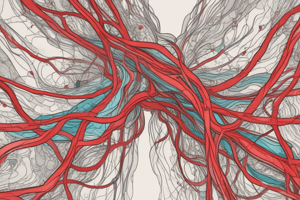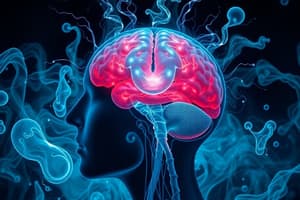Podcast
Questions and Answers
Which of the following is true regarding cerebral autoregulation?
Which of the following is true regarding cerebral autoregulation?
- Cerebral autoregulation is not affected by changes in mean arterial pressure (MAP).
- Cerebral autoregulation is primarily controlled by changes in intracranial pressure (ICP).
- Cerebral autoregulation is only effective in maintaining a consistent CBF of 50 mL/100 g/min in healthy brains.
- Cerebral autoregulation is believed to be intact between a MAP of 60 to 160 mmHg. (correct)
What happens to cerebral blood flow (CBF) when CPP decreases below the lower limit of autoregulation (LLA)?
What happens to cerebral blood flow (CBF) when CPP decreases below the lower limit of autoregulation (LLA)?
- CBF becomes pressure-dependent, and maximal cerebral vasodilation occurs. (correct)
- CBF increases in response to decreased CPP.
- CBF remains constant at 50 mL/100 g/min.
- CBF decreases proportionally to the decrease in CPP.
What can happen when CPP exceeds the upper limit of autoregulation?
What can happen when CPP exceeds the upper limit of autoregulation?
- Cerebral autoregulation becomes more effective at maintaining a consistent CBF.
- Cerebral vessels are maximally vasoconstricted, and increased perfusion pressure can cause disruptions such as blood-brain barrier (BBB) disruption, cerebral edema, or cerebral hemorrhage. (correct)
- Cerebral vessels dilate, leading to increased CBF and improved brain function.
- CVR decreases, leading to decreased CBF and potential cerebral ischemia.




